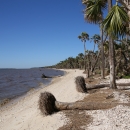About Us
Our Mission
"to protect, maintain, and enhance the unique barrier islands that compose the refuge for the benefit of present and future generations, while protecting the colonial nesting birds. "
Our History
Cedar Keys National Wildlife Refuge was established on July 16, 1929,
by Presidential Executive Order 5158, to protect a breeding ground for colonial nesting migratory birds. The Executive Order included North Key, Snake Key, and Bird (Deadman's) Key. A second Executive Order, dated November 6, 1939, added Seahorse Key to the refuge. Congressional legislative mandate number 92-364, dated August 7, 1972, designated Seahorse Key, Snake Key, North Key, and Deadman's Key as National Wilderness Areas under the Wilderness Act of September 3, 1964 (Public Law 88-577). During the late 1970s and 1980s, additional interior coastal islands surrounding the town of Cedar Key were purchased for inclusion in the refuge. In 1998, the Suwannee River Water Management District purchased Atsena Otie Key and added it to Cedar Keys Refuge through a Memorandum of Understanding. Today, Cedar Keys Refuge is comprised of 13 islands ranging in size from 1 to 120 acres and totaling 762 acres.
Other Facilities in this Complex
Cedar Keys is managed as part of the North Florida Refuge Complex. A National Wildlife Refuge Complex is an administrative grouping of two or more refuges, wildlife management areas or other refuge conservation areas that are primarily managed from a central office location. Refuges are grouped into a complex structure because they occur in a similar ecological region, such as a watershed or specific habitat type, and have a related purpose and management needs. Typically, a project leader or complex manager oversees the general management of all refuges within the complex and refuge managers are responsible for operations at specific Refuges. Supporting staff, composed of administrative, law enforcement, refuge manager, biological, fire, visitor services, and maintenance professionals, are centrally located and support all refuges within the complex.
The North Florida Refuge Complex headquarters is located at 1255 Lighthouse Road, St. Marks, FL 32355.




